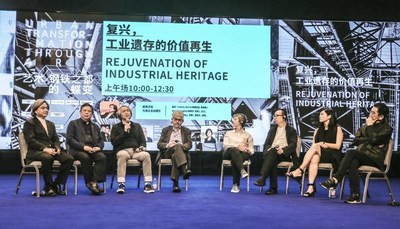International Experts Discussed "Urban Transformation Through Art" at SIAC in Shanghai
Comunicato Precedente

Comunicato Successivo

Prof. Hang Jian, China Academy of Art, spoke about 100,000 ambitious heritage conservation plans currently under way by Chinese government, which includes regenerating the industrial heritage as well as conservation plans for traditional Chinese rural areas and their way of life. China has more than 5,000 years of history but the experience of industrialization is only 160 years.
On the first day, participants visited the industrial heritage site of Bao Steel and felt the sweat that workers poured for the prosperity and industrialization of China. One of the participants suggested that Bao Steel's industrial heritage should be permanently preserved as a sacred work site through minimal restoration.
The forum was divided into four different research topics under the main title "Urban Transformation through Art", a subject suggestive redevelopment of industrial heritage. The forum also discussed rejuvenation plans that utilize arts and how to revitalize industrial heritage through architecture and urban planning.
Summary of the discussion
1. A museum is not just a place for exhibition and a temple of collections but a platform for the public to relate, participate and suggest their active opinions. The audience today are not passive visitors to be educated by professionals of institutions but an opinionated neighbor. Museums should transfer their ownership to the audience.
2. Relative success stories of industrial rejuvenation have been introduced in the west and in China. Orsay Museum in Paris from train station, Venice Biennale Arsenale Exhibition Space refurbished from shipbuilding and ship-fixing space, Hamburger Bahnhof Museum in Berlin from Berlin train-station, Wiels Contemporary art center in Belgium, etc. In China, Chin Pagoda and Hangzhou Pagoda were also introduced by Stephen Hughes, secretary general of TICCIH. But unagreeable industrial rejuvenation cases have not been introduced. Success stories vary and are debatable. Failure cases are all varied and debatable as well.
3. Why are most success stories of Industrial Heritages transformation focused on art museums, art centers or art-oriented facilities? Is art so important? Is art a victim? Is it simply because making art-related spaces is cheap? Is art casual, easy or at stake? Why not architecture?
4. Industrial Heritage Rejuvenation should be able to preserve not only memory of the process of conservation but also of the history of users. Industrial heritage regeneration is understood as a surgery or demolition of buildings. But it could be a nutritional injection and reconnection to the history.

5. SIAC (Shanghai International Art City) shouldn't be a city of tourism with art. Art city is not a tourist city that uses art, but the quality of the city is more important. Quality is a guarantee of life.
6. Rejuvenation is about reusing. It is like two sticks which are called chopsticks, not a single chopstick, which is almost useless. Art is like Chinese chopsticks. Baowu heritage site is 26 square kilometers but in reality, there are 230 square kilometer sites in Shanghai that need to be rejuvenated.
7. The relationship between art and rejuvenation of city is not inevitable and conclusive. Is it because art is cheaper than any other medium? Urban Transformation Through Art? Why not through architecture?
8. Community culture needs to be related to the SIAC context. Eva Franch i Gilabert said that she doesn't work with business models in her architectural practice but an idea model. It alludes to the future of SIAC.
9. The difference of value and capital are crucial matters that need to be reconsidered in the field of art given recent environments.
10. Why do we pay attention to the legacy of the past? What is the role of heritage? What about living heritage? Energy of creating space and energy of memory go together.
11. SIAC should also be a city for education for future generations.
12. Academic Director of the forum, Yongwoo Lee, said in a conclusive comment "we make a house but the house shapes us. We don't seem to think that the city we create shapes the framework of our actions, habits and values."
Logo - https://mma.prnewswire.com/media/694193/SIAC_Roundtable.jpg





